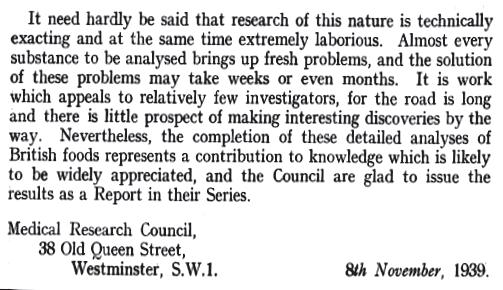
2 minute read
Nutrition Society Training Academy (NSTA)
Penny Hunking, Honorary Training Academy Officer
written by hand by Alison with her best fountain pen. This went directly to the printer for creation of proofs, which were checked by Alison reading it out loud to David Southgate every afternoon. The M&W4 cover photo is of the lab at the DUNN, with the proofs of the 4th edition seen in the background. Again, thanks to computers, it is now much simpler for us to produce a print ready version for the Royal Society of Chemistry to publish.
Advertisement
Timescale: It took Alison seven years to complete the 4th edition, from starting work, to the publication of the book, with two years dedicated just to completing the meats. Nowadays, updates are simpler as publication is quicker and easier with the online resource, so we have a rolling program of updates. However, we do know that there is nothing better than flicking through the book!
Regulations: The data created for the M&W series allow for dietary analysis and the creation of public health messages. Alison has paperwork showing the public health message in the 1960s was not to eat too much sugar. Some things never change.
It’s worth finishing with the preface from the first version to show that the thinking and work behind the compilation of Food Composition tables has not really changed in 80 years. “… research of this nature is technically exacting and at the same time extremely laborious. Almost every substance to be analysed brings up fresh problems and the solution may take weeks or even months”
At Food Databanks we proudly carry on in the footsteps of McCance, Widdowson, Southgate and Paul, because we know that the dataset is widely appreciated and is the backbone of public health nutrition and food and health research in the UK and beyond.
You can access the McCance and Widdowson’s The Composition of Foods
Integrated Dataset on the PHE website: www.gov.uk/government/publications/ composition-of-foods-integrated-datasetcofid
When the decision was made for the Society’s Training schedule to be taken online in the form of webinars, it was a significant change after years of hosting workshops at the Society’s London offices. This decision was triggered by a change in the way in which the membership was engaging with the Society, but also in looking to continually deliver the best possible effective offerings for the membership. By transferring training content online through the Training Academy (NSTA), it was hoped that the Society’s mission of enhancing the scientific study of nutrition and its application to the maintenance of human and animal health would be more achievable. Now, the travel element has been eliminated along with reducing the associated costs and time spent away from offices and homes. The NSTA has resultantly reached over 35 countries with its training offerings, from its membership representation across 80 countries.
Back in 2018, nobody could have predicted the unprecedented times the world would face in 2020; potentially changing the way in which nutrition professionals, scientists and the global population now operate. With the NSTA already established online, it was immediately recognisable that the Society could and would continue to deliver its training objectives despite remote working. Staff and webinar hosts were still able to operate irrespective of location to deliver the Society’s training, whilst all attendees were able to adhere to the government guidelines in place without hesitation. Since then, the NSTA has seen engagement increase, thanks to a committed membership base looking to enhance their CPD, despite the times surrounding us. This is so encouraging at a time when research-evidenced based information is more important than ever.
In those challenging times when the difficult decision to cancel the Society’s annual Summer Conference was made; the flagship networking opportunity amongst members, it was quickly realised that the Society’s various sectors (training, conferences and publications) could work together to deliver an online event to bring the membership together, even from afar. Resultantly, Nutrition Society Live 2020 was launched. Whether you attended or are interested to hear about the potential for future ‘Nutrition Society Live’ events, the following article provides a snapshot of how members and colleagues came together to hear the latest scientist, engaged with Original Communications and networked with old friends and colleagues, irrespective of unprecedented barriers.








